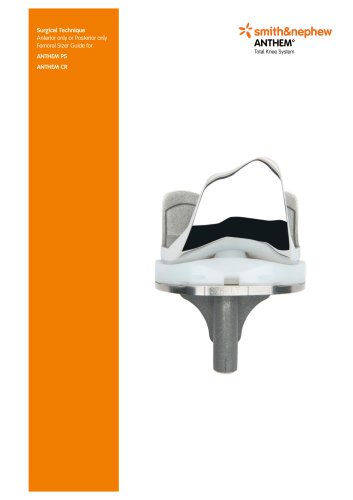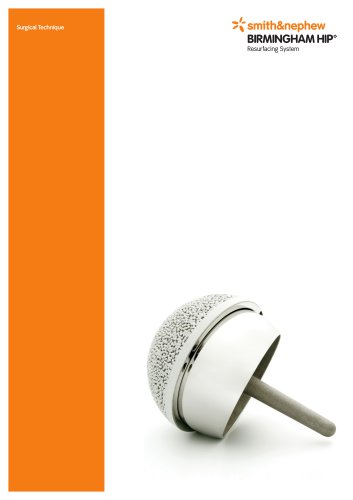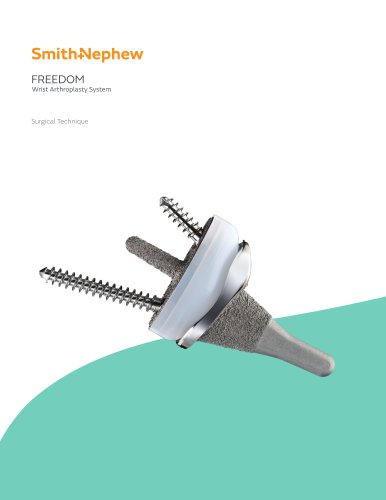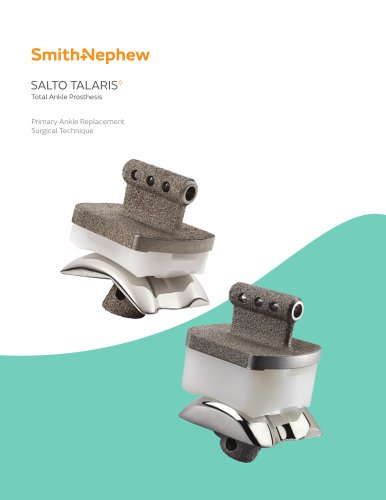
Catalog excerpts

Our Products in Clinical Studies The TAYLOR SPATIAL FRAME™ for External Fixation A Systematic Literature Review Following 20 years of Clinical Outcomes Use this QR code to access the main Bone&JointOutcome review online [SN16015] Bone&JointOutcome Taylor Spatial Frame 06.indd 1
Open the catalog to page 1
Authors: Sheila Sprague PhD1,2,3 , Elizabeth Nguyen BSc1, Mark Phillips BSc1, Mohit Bhandari MD, PhD, FRCSC 1,2,3 , John Watson 4 1 Global Research Solutions Inc., Burlington, ON, Canada 2 Centre for Evidence-Based Orthopaedic Surgery, Division of Orthopaedic Surgery, Department of Surgery, McMaster University, Hamilton, ON, Canada 3 Department of Clinical Epidemiology and Biostatistics, McMaster University, Hamilton, ON, Canada 4 Scientific & Medical Affairs Department, Smith & Nephew Orthopaedics AG, Baar, Switzerland APPEN DICES The TAYLOR SPATIAL FRAME™ for External Fixation: A...
Open the catalog to page 2
The TAYLOR SPATIAL FRAME™ for External Fixation: A Systematic Literature Review Following 20 years of Clinical Outcomes Study characteristics This systematic review was performed to evaluate and summarize the current evidence of the clinical performance of the TAYLOR SPATIAL FRAME (Smith & Nephew, Memphis, TN, USA). Background Since its introduction in 1996, several studies have reported positive clinical results with the TAYLOR SPATIAL FRAME external fixator. In order to obtain a more thorough understanding of this device’s performance, we conducted a systematic review of the literature...
Open the catalog to page 3
External fixation plays a growing role in the primary treatment of unstable and high risk fractures, non- and malunions, as well as in the reconstruction of congenital and acquired physical deformities. TAYLOR SPATIAL FRAME (Smith & Nephew, Memphis, TN, USA; Figure 1) is an external fixator that uses computer software to simultaneously correct for leg length discrepancy and various aspects of deformity including angulation, translation, and rotation. TAYLOR SPATIAL FRAME consists of two rings or partial rings connected by six telescopic struts at special universal joints to create a hexapod...
Open the catalog to page 4
Although some of the 44 studies were of greater than Level IV evidence, for our purposes they are all considered Level IV case series. This is because only one study arm was included or the study arms were considered independently of one another. Please refer to Appendix 1: Methods for further detail on the eligibility criteria and literature search. This review pools data from clinical studies reporting consolidation rates, time to consolidation, rate of correction goals achieved (specific to deformities), and complications following treatment with TAYLOR SPATIAL FRAME™ in adults and...
Open the catalog to page 5
Results pp 6–13 Study Characteristics Study characteristics are summarized in Figure 3. Details on the 44 included studies are provided in Tables 1-3, beginning on page 16. Please refer to Appendix 2: Results for additional details on the study results. Figure 3: Study characteristics Acute Trauma Retrospective comparative & case series Retrospective comparative & case series Prospective & retrospective comparative & case series Mean follow-up (months): Sample size (mean): Number of fractures/ deformed limbs (mean) Study designs included: Retrospective comparative & case series Case series...
Open the catalog to page 6
Results Cont. Consolidation Rates—Adults In adults, mean consolidation rates were as follows for the three indications: • Acute trauma: 99.2% (four studies reporting1,27,30,37) • Non/malunion: 100% (four studies reporting18,25,36,41) • Deformities: 100% (two studies31,39) Figure 4: Consolidation rates of TAYLOR SPATIAL FRAME™ for three indications in adults. Study (Operations) Ahearn et al. 2014; n=21 Lahoti et al. 2013; n=72 Menakaya et al. 2014; n=37 Sala et al. 2013; n=57 Pooled Results, Non/Malunion; n=80 Feldman et al. 2003*; n=18 Khunda et al. 2016*; n=40 Sala et al. 2011; n=12...
Open the catalog to page 7
Results Cont. Time to Consolidation Rates—Adults In adults, mean consolidation rates were as follows for the three indications: • Acute trauma: 21.8 weeks (four studies23,27,30,37) • Non/malunion: 32.8 weeks (three studies18,25,41) • Deformities: 4.1 weeks (five studies8,20,33,34,43) Figure 6: Time to consolidation of TAYLOR SPATIAL FRAME™ for three indications in adults. Mean Time to Consolidation (Weeks) Pooled Results, Acute Trauma; n=157 Henderson et al. 2015; n=56 Lahoti et al. 20131; n=7 Menakaya et al. 2014; n=37 Sala et al. 20135; n=57 Pooled Results, Non/Malunion; n=68 Feldman et...
Open the catalog to page 8
Results Cont. Consolidation Rates—Children In children, mean consolidation rates were as follows for the three indications: • Acute trauma: 100% (four studies3,7,40,44) • Non/malunion: 100% (one study5) • Deformities: 100% (two studies4,38) Figure 5: Consolidation rates of TAYLOR SPATIAL FRAME™ for three indications in children. Consolidation Rate (%) Pooled Results, Acute Trauma; n=48 Al-Sayyad 2006; n=10 Blondel et al. 2010; n=11 Tafazal et al. 2014; n=15 Zenios 2013; n=12 Pooled Results, Non/Malunion; n=12 Pooled Results, Children; n=29 Study (Operations) Percentages may not add to 100%...
Open the catalog to page 9
Results Cont. Correction Goals Achieved—Adults and Children The total number of correction goals achieved, a commonly reported outcome in the indication of deformities, was 98.1% for adults (7 studies2,8,15,20,26,34,43) and 94.3% in children (14 studies6,8-14,16,17,19,20,22,35). Figure 8: Rate of correction goals achieved with TAYLOR SPATIAL FRAME™ for deformities in adults and children. Rate of Correction Goals Achieved (%) Pooled Results, Adults; n=255 Pooled Results, Children; n=336 Study (Year) Percentages may not add to 100% due to rounding 1 P aper reports on the group with fibular...
Open the catalog to page 10
Results Cont. Complication Rates Total number of complications were pooled from the included articles that investigated TAYLOR SPATIAL FRAME™. For all three indications combined, the overall rate of complications per fracture or deformity was 43.0% and 54.2% in adults and children, respectively. These complications were classified according to severity using a modified grading system by Donnan et al45 (see Appendix). Grade I complications do not require operative interventions, whereas Grades II–IV do. Incidence rates were developed for the following categories: no complications,...
Open the catalog to page 11All Smith & Nephew catalogs and technical brochures
-
ANTHEM
40 Pages
-
BIRMINGHAM HIP
32 Pages
-
FREEDOM
16 Pages
-
SALTO TALARIS
48 Pages
-
polarstem
28 Pages
Archived catalogs
-
Locking Large Fragment Overview
32 Pages
-
Locking Small Fragment Overview
68 Pages
-
Rediscover normal
4 Pages
-
TWINFIX ULTRA HA and PK
2 Pages
-
TRIGEN™ INTERTAN
12 Pages
-
EVOS SMALL Resources
12 Pages
-
NAVIO Message Brochure
8 Pages
-
Small footprint, big impact
8 Pages
-
TAYLOR SPATIAL FRAME◊
8 Pages
-
Recertification Program
8 Pages
-
anthem
4 Pages
-
Ordering information
1 Pages
-
BST-CarGel ®
20 Pages
-
RAPID RHINO™ NASASTENT™
6 Pages
-
clancy anatomic cruiciate
2 Pages
-
Electrosurgery
20 Pages
-
Powered Instruments
11 Pages
-
Shaver Systems
7 Pages
-
Knee
73 Pages
-
HIP
21 Pages































